Mia Naeini
Resilient Temporal GCN for Smart Grid State Estimation Under Topology Inaccuracies
Oct 21, 2024Abstract:State Estimation is a crucial task in power systems. Graph Neural Networks have demonstrated significant potential in state estimation for power systems by effectively analyzing measurement data and capturing the complex interactions and interrelations among the measurements through the system's graph structure. However, the information about the system's graph structure may be inaccurate due to noise, attack or lack of accurate information about the topology of the system. This paper studies these scenarios under topology uncertainties and evaluates the impact of the topology uncertainties on the performance of a Temporal Graph Convolutional Network (TGCN) for state estimation in power systems. In order to make the model resilient to topology uncertainties, modifications in the TGCN model are proposed to incorporate a knowledge graph, generated based on the measurement data. This knowledge graph supports the assumed uncertain system graph. Two variations of the TGCN architecture are introduced to integrate the knowledge graph, and their performances are evaluated and compared to demonstrate improved resilience against topology uncertainties. The evaluation results indicate that while the two proposed architecture show different performance, they both improve the performance of the TGCN state estimation under topology uncertainties.
Embedding-based Multimodal Learning on Pan-Squamous Cell Carcinomas for Improved Survival Outcomes
Jun 11, 2024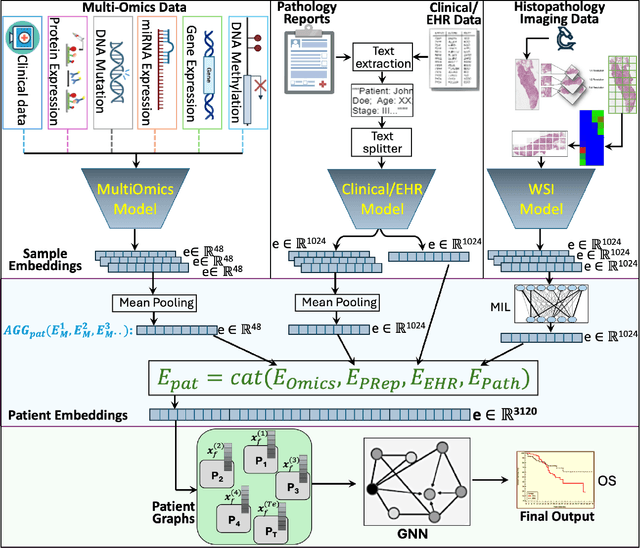
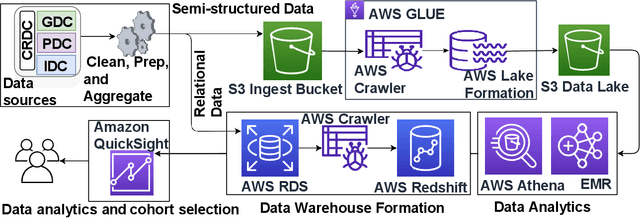
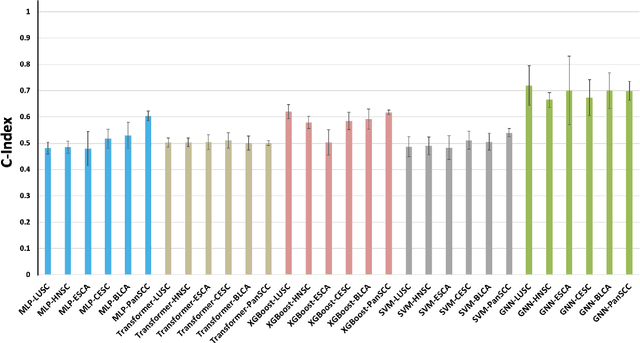

Abstract:Cancer clinics capture disease data at various scales, from genetic to organ level. Current bioinformatic methods struggle to handle the heterogeneous nature of this data, especially with missing modalities. We propose PARADIGM, a Graph Neural Network (GNN) framework that learns from multimodal, heterogeneous datasets to improve clinical outcome prediction. PARADIGM generates embeddings from multi-resolution data using foundation models, aggregates them into patient-level representations, fuses them into a unified graph, and enhances performance for tasks like survival analysis. We train GNNs on pan-Squamous Cell Carcinomas and validate our approach on Moffitt Cancer Center lung SCC data. Multimodal GNN outperforms other models in patient survival prediction. Converging individual data modalities across varying scales provides a more insightful disease view. Our solution aims to understand the patient's circumstances comprehensively, offering insights on heterogeneous data integration and the benefits of converging maximum data views.
SeNMo: A Self-Normalizing Deep Learning Model for Enhanced Multi-Omics Data Analysis in Oncology
May 13, 2024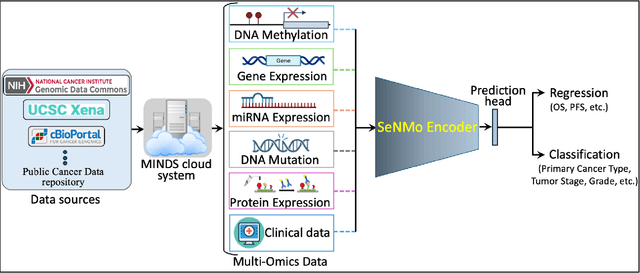
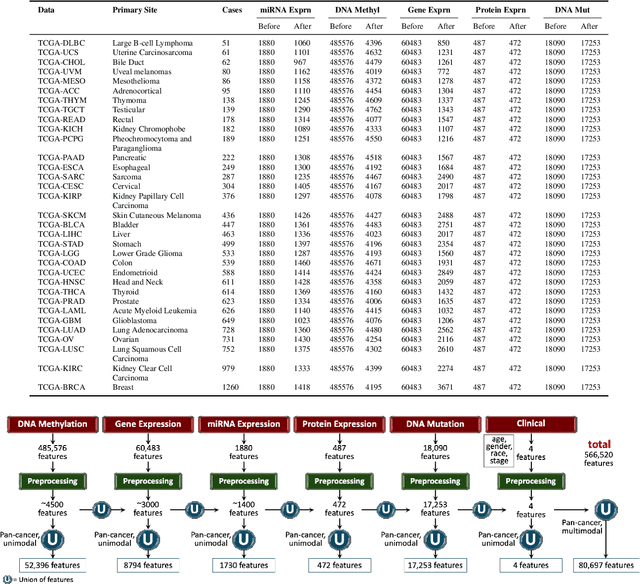


Abstract:Multi-omics research has enhanced our understanding of cancer heterogeneity and progression. Investigating molecular data through multi-omics approaches is crucial for unraveling the complex biological mechanisms underlying cancer, thereby enabling effective diagnosis, treatment, and prevention strategies. However, predicting patient outcomes through integration of all available multi-omics data is an under-study research direction. Here, we present SeNMo (Self-normalizing Network for Multi-omics), a deep neural network trained on multi-omics data across 33 cancer types. SeNMo is efficient in handling multi-omics data characterized by high-width (many features) and low-length (fewer samples) attributes. We trained SeNMo for the task of overall survival using pan-cancer data involving 33 cancer sites from Genomics Data Commons (GDC). The training data includes gene expression, DNA methylation, miRNA expression, DNA mutations, protein expression modalities, and clinical data. We evaluated the model's performance in predicting overall survival using concordance index (C-Index). SeNMo performed consistently well in training regime, with the validation C-Index of 0.76 on GDC's public data. In the testing regime, SeNMo performed with a C-Index of 0.758 on a held-out test set. The model showed an average accuracy of 99.8% on the task of classifying the primary cancer type on the pan-cancer test cohort. SeNMo proved to be a mini-foundation model for multi-omics oncology data because it demonstrated robust performance, and adaptability not only across molecular data types but also on the classification task of predicting the primary cancer type of patients. SeNMo can be further scaled to any cancer site and molecular data type. We believe SeNMo and similar models are poised to transform the oncology landscape, offering hope for more effective, efficient, and patient-centric cancer care.
Characterizing the Effects of Single Bus Perturbation on Power Systems Graph Signals
Jun 05, 2023Abstract:This article explores the effects of a single bus perturbation in the electrical grid using a Graph Signal Processing (GSP) perspective. The perturbation is characterized by a sudden change in real-power load demand or generation. The study focuses on analyzing the spread of the perturbation throughout the grid and proposes a measure of spreadability based on GSP. Moreover, the global and local smoothness properties of the difference bus voltage angle graph signals are evaluated for understanding their embedded patterns of spreadability property. It is demonstrated that the global smoothness of the bus voltage angle graph signal follows a quadratic relationship with the perturbation strength, which helps in characterizing the critical perturbation strength after which the power flow diverges indicating a stressed system. The impact of a single bus perturbation on power system graph signals has been investigated through both analytical derivations using the DC power flow model and simulation using the AC power flow model. The results reveal that the proposed measure of spreadability as well as local and global smoothness properties of the graph signals are independent of the perturbation strength and instead mainly depend on the perturbation's location.
A Temporal Graph Neural Network for Cyber Attack Detection and Localization in Smart Grids
Dec 07, 2022Abstract:This paper presents a Temporal Graph Neural Network (TGNN) framework for detection and localization of false data injection and ramp attacks on the system state in smart grids. Capturing the topological information of the system through the GNN framework along with the state measurements can improve the performance of the detection mechanism. The problem is formulated as a classification problem through a GNN with message passing mechanism to identify abnormal measurements. The residual block used in the aggregation process of message passing and the gated recurrent unit can lead to improved computational time and performance. The performance of the proposed model has been evaluated through extensive simulations of power system states and attack scenarios showing promising performance. The sensitivity of the model to intensity and location of the attacks and model's detection delay versus detection accuracy have also been evaluated.
 Add to Chrome
Add to Chrome Add to Firefox
Add to Firefox Add to Edge
Add to Edge